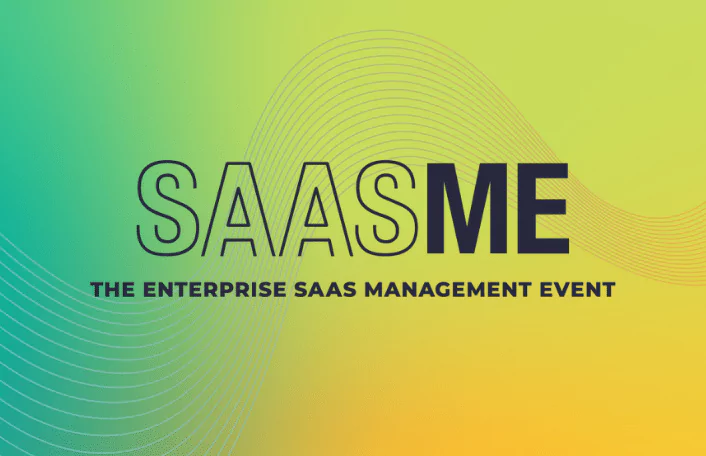04/23/2024
Table of Contents
That’s a wrap on SaaSMe 2024, another fantastic event for the books! The fourth annual conference is still the industry’s only dedicated Enterprise SaaS Management event.
On April 16-17, IT, Software Asset Management, and Procurement leaders gathered (virtually) to learn, network, and exchange ideas on how to manage software costs more effectively, reduce risk, and drive real change at their organizations. This year’s event attracted hundreds of attendees representing companies ranging from some of the world’s most recognizable enterprises – to the most innovative startups.
Day One centered on breaking the status quo to drive business impact through effective, holistic SaaS Management. Sessions covered a range of topics, such as:
- A Crawl-Walk-Run Framework for Mastering Enterprise SaaS Program Management
- Out with the Old: How to Shake Off the SaaS Management Status Quo
- How to Make Intelligent Renewal Decisions
- Building & Promoting Your SaaS Management Strategy and Program: Maximizing Value and Adoption
- Multiplying the Power of Software Management with an SMP and SAM Tool
- Choosing the Right Governance Approach for Your Company
- Reducing License Waste in the Enterprise
Day Two was exclusive to Zylo customers. Through hands-on learning and peer-to-peer roundtable discussions, attendees discovered how to get even more value from Zylo’s platform and services.
More and more IT, SAM, and Procurement leaders are saying “no” to the status quo and “yes” to SaaS Management. And they’ve become real changemakers for their organizations. Watch all the SaaSMe 2024 sessions here, and read below for five key takeaways to get you started on your own SaaS Management journey.
SaaSMe 2024 Takeaway #1: Change Your Mindset, Or Get Left Behind
The quickest way to get left behind is to be stuck in the past. SaaS has been around for decades and has made its stake in the ground. It’s here to stay.
That doesn’t mean you need to throw your whole approach out the window. While some of the same principles of software management apply to SaaS, it requires a new way of thinking to do it well.
 For Gordon Atkin, VP, Technology & Business Platforms at Salsify, seeing the organization’s full inventory of SaaS applications made him realize they needed to do things differently.
For Gordon Atkin, VP, Technology & Business Platforms at Salsify, seeing the organization’s full inventory of SaaS applications made him realize they needed to do things differently.
“We did our own personal inventory, which came up with 150 applications. And then we engaged with Zylo. [After going through discovery], we had well over 300 applications.”
At AbbVie, it was the combination of factors that led its asset management team to use a SaaS Management platform.
“We’re doubling in size. We don’t have a handle on all of our SaaS-based software. We only know what’s in the spreadsheet and there are missed renewals that occurred,” said Renee Turco, Sr. Manager, Technology Asset Management at Abbvie. “We had inconsistencies in reporting and had no idea what our shadow IT was from an expense perspective, because we didn’t have insights into corporate credit card spend of software.”
SaaSMe 2024 Takeaway #2: Manage SaaS and On-Prem Software Together
Today, one tool just doesn’t cut it to effectively manage your software estate. Software Asset Management tools were designed specifically for on-prem and do an excellent job. Likewise, SaaS Management platforms were purpose-built for SaaS.
The question is not, “Can I use a software asset management tool to manage SaaS?” But rather, “How can I use them together to power my software management program?”
In the past, software was physically hosted on-site, and enterprises were focused on compliance and effective license position (ELP) delivery. Today, you can simply log into the vendor’s portal and see your ELP.
“You have to be able to do both effectively in order to manage your software portfolio,” said Jason Owens, Senior Director, Global ITAM at Salesforce. “It’s finding that healthy tension and where the low-hanging fruit and the largest value drivers are that will bring value to you, and your career, and your company that you can either reinvest or return to stakeholders.”
So, why do you need two different tools? Owens went on to explain, “It’s because you have two fundamentally different types of software in enterprise and you need to be able to manage them both well.”
SaaSMe 2024 Takeaway #3: Don’t Bite It All Off at Once
There are a lot of moving parts when it comes to SaaS Management. But the thing to remember is that you can’t bite it all off at once.
Every SaaS Management program begins with visibility into all the SaaS in your inventory. You can’t manage what you can’t see. From there, you choose your own journey.
Cory Wheeler, co-founder and chief customer officer at Zylo, said it perfectly. “You need to think about SaaS Management within a model that is consumable. You need to understand where you are today and then map out where you’re going and what that looks like, which is different for every single enterprise.”
 As VP, Digital Business at ModMed, Trenton Cycholl likes to tier the organization’s applications to prioritize how they will manage and optimize software.
As VP, Digital Business at ModMed, Trenton Cycholl likes to tier the organization’s applications to prioritize how they will manage and optimize software.
“Our equation centered on the lowest license usage, timing of contractor rules, and tiering of our applications and technology stacks,” said Cycholl. “Like many of you IT professionals that might be in this session, the mountain of technology can be significant. So, prioritizing platforms was very valuable for us.”
SaaSMe 2024 Takeaway #4: Be a Catalyst for Change in Your Organization
As IT, Software Asset Management, and Procurement leaders, you have an incredible opportunity to be changemakers in your organizations. This is your chance to adopt a new mindset for how you manage software, elevate your executive presence, and ultimately drive more value for the business.
 According to Samantha Griffin, Senior Manager, Software Asset Management at Genesys, elevating your personal brand starts with understanding “the small values and everyday work that software asset management can provide.”
According to Samantha Griffin, Senior Manager, Software Asset Management at Genesys, elevating your personal brand starts with understanding “the small values and everyday work that software asset management can provide.”
But you also need to see the big picture. How does SAM create a solid infrastructure for your organization? How does it align with finance, enterprise architecture, sourcing, InfoSec, etc.?
When it comes to building trust with leadership, Griffin recommends crafting a compelling story. “Make sure that whenever you are in the room presenting [to leadership] on what you can do and the change that you can make, it’s backed up by data.”
To become a catalyst for change at your organization, start engaging your leadership team in a thoughtful way. Have candid conversations. Stay curious. And be open to new ways of doing things.
SaaSMe 2024 Takeaway #5: Make It a Team Effort
As Velma Kelly in Chicago says, “But I can’t do it alone,” the same goes for SaaS Management. The truth is, your peers in IT, SAM, and Procurement often have similar goals – like improving efficiency, reducing costs, and improving the employee experience. Your program will be much more effective if you join forces and drive toward shared goals together.
 “The way that I describe how we all work together is like a relay race,” said Jessica Moser, Global Senior Procurement Manager at QAD, on procurement’s relationship with IT.
“The way that I describe how we all work together is like a relay race,” said Jessica Moser, Global Senior Procurement Manager at QAD, on procurement’s relationship with IT.
For instance, the QAD procurement and IT teams meet weekly to review renewals. On the IT side, “Jim and team are experts on what that application is. They also know, in conjunction with the business unit, who we need to connect with and decide how we move forward. They start the relay race.”
From there, it goes to their SaaS Negotiator, “who really helps align with the strategic direction of the business. They work directly with the business, IT, and the vendor, making sure that we get the best price and get what we need to complete that transaction.”
“Then they hand it off to me and procurement and my team,” Moser went on to explain, “and we make sure we have the proper contract terms and the proper approvals in place. We make sure that everybody’s aware of this transaction, finance has approved, budgeting has approved. And then we ultimately get that contract signed and get that over to purchase orders. So, none of that would happen just with one team alone.”
In the end, collaboration wins.



